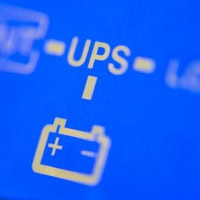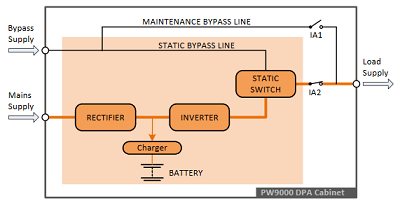The massive power cut that hit the UK on August 9th exposed our vulnerability to such events at two levels – the risk of such incidents occurring at all; and the disproportionate amount of time needed to recover from the effects of even a relatively brief blackout. Against this background, the cost of a well-managed power protection system seems a small price to pay when you consider the possible alternative.
Blackout causes and repercussions
The outage, which was the UK’s biggest in a decade, left millions of homes and businesses in England and Wales without electricity. After knocking out traffic lights, disrupting public transport nationwide and affecting vital hospital services, the incident will be subject to a government committee inquiry.
It started with a routine blip – the gas-fired power station at Little Barford in Bedfordshire shut down at 16:58 BST due to a technical issue. Then, things became non-routine when a second power station, the new Hornsea offshore wind farm, also “lost load”. The turbines were still moving, but power was not reaching the grid. This prompted automated systems to activate and prevent unmanageable demand pulling down the grid supply frequency and damaging the UK electricity infrastructure.
Experts say that there is no reason for wind farms to disconnect from the grid more than other generators. However, gas and coal-fired power stations have more flexibility. When one drops off, it’s easier for another to pick up the slack.
The blackouts were resolved relatively quickly. The power stations were back in action after 15 minutes and National Grid says local power suppliers were meeting demand by 17:40 BST. However, the effects lasted for long afterwards, particularly across the rail network – with some disruptions continuing until the following day.
Some trains to the north of London had to be manually restarted by technicians. The blackout also affected signalling systems and power supply equipment; although back-up systems stepped in, safety requirements caused delays. Passengers reported travelling for 12 or 13 hours, with some being stuck on trains until the early hours of Saturday morning.
Other consequences included 15 minutes’ loss of power at Ipswich Hospital after emergency generators failed to start. These high-profile issues may receive the lion’s share of the headlines but that doesn’t mean many other businesses and organisations didn’t face similar challenges in the aftermath. For example, one a business reported that four of their computers failed to restart after power was restored, meaning expense and time was spent obtaining replacements and installing the necessary software.
Industry experts – and government – are querying the National Grid’s contingency planning – why did the failure of just two power stations cause such a widespread blackout? Why couldn’t other capacity be switched in to share the load?
Another concern is the lack of visibility about setpoints. In other words, it’s understood that the Grid will start to shed loads according to pre-arranged setpoints in response to loss of capacity, to avoid a dangerous drop in mains frequency. However, it isn’t known how they prioritise, or which setpoints they select first.
For their part, the National Grid recognises that it could take months to work through the lessons of the failure. The level of impact inflicted makes it imperative to minimise disruption in the future.
Protect yourself: UPS, generator and emergency lighting solutions
So, while the government’s Energy and Emergencies Executive Committee investigates whether the National Grid’s procedures are fit for purpose, it is vital that organisations assess their own level of risk, understand the true implications of an extended backout, and whether existing power protection measures are fit for purpose. No business should be like the examples above, and see their computers destroyed immediately the power fails, making a UPS system essential for most. However, in the event of an extended blackout, a complete UPS-generator package is often a better if not essential solution.
On-line double conversion UPSs such as KUP’s PowerWAVE ranges provide the best initial defence against grid power problems. When normal power is available, the UPSs’ internal electronics protect the load from mains-borne problems such as transients or brownouts. If the mains power does fail, the UPS battery and inverter take over the load without interruption.
What happens next depends on the UPS’s battery autonomy. If continued operation of the load is not critical, then a few minutes’ autonomy may suffice; this will allow the IT systems to shut down gracefully, without loss of data or damage to hardware. However, operations will still be impacted if the power is not restored immediately.
Alternatively, if continued operation under all circumstances is essential, then one possibility is to increase battery autonomy. However, battery autonomies are finite and can always be exhausted by a prolonged blackout.
The only solution guaranteed to outlast blackouts of any duration is to provide an integrated UPS and generator package. When the power fails, the UPS battery switches in immediately, while the mains failure relay sends an initiation signal to the generator. Once the generator has started up and stabilised, the UPS will accept it as a mains replacement, so it can continue to support the critical load for as long as necessary. It also recharges the UPS batteries.
How a UPS & Generator work together
When sourcing an integrated UPS-generator solution, it’s essential to work with an established supplier that understands the entirety of the requirement. For KOHLER Uninterruptible Power, its experience, products and 24/7 support encompass both UPS and generator technologies. It can foresee any issues arising not just from each piece of equipment, but also from how they interact with one another.
As a result, they can prevent an event that lasts just minutes or even seconds, yet has repercussions extending into weeks, months or even longer.
Finally, another consideration worth understanding are the safety implications of a blackout. In any business premises, emergency lighting is a legal requirement, with products needing to comply with British Standard 5266-1. Emergency lighting systems can be installed as part of the overarching UPS and generator system, but often sit independently, utilising a separate and much smaller set of batteries, while providing extended autonomy – typically lasting for as much as three hours to ensure everyone has the required time to evacuate.
Emergency lighting, like any UPS or generator system, requires regular technical maintenance, but of equal relevance is understanding if the system is still able to meet the needs of the building or buildings it supports. Renovations, extensions or even cosmetic lighting updates can all impact the size of the emergency lighting load so it is vital that the system is tested at regular intervals to ensure it continues to offer adequate protection and the necessary battery autonomy.
For a quote or help on specifying UPS, generator or emergency lighting systems, please contact us on 0800 731 3269 or email us at [email protected]






